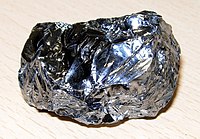
Photo from wikipedia
ABSTRACT The use of graphitic-C3N4 as a photocatalyst has gathered enormous attention in the area of photocatalysis. Herein, Boron doped phenyl ring incorporated (PhCN) is set up by the hydrothermal… Click to show full abstract
ABSTRACT The use of graphitic-C3N4 as a photocatalyst has gathered enormous attention in the area of photocatalysis. Herein, Boron doped phenyl ring incorporated (PhCN) is set up by the hydrothermal technique using various synthons like benzamide, urea, and boron oxide. The prepared active catalyst is characterized by using standard analytical techniques. The activity of the synthesized xB/PhCN is tested by studying the decolorization of methyl orange (MO) and rhodamine B (RhB) under illumination. All synthesized composites (B-doped-PhCN) showed better activity compared with a pure sample of PhCN. The XRD patterns indicate that the most active catalyst is quite a stable catalyst even after the photolysis experiment. The mechanistic pathway studied via trapping of main reactive species indicates that hydroxide radical (•OH), and superoxide radical anions (O2•−) play a major role in the photooxidation of both dyes. In light of this, a reasonable route for photooxidation of pollutants via charge carrier separation has been proposed.
Journal Title: Surfaces and Interfaces
Year Published: 2021
Link to full text (if available)
Share on Social Media: Sign Up to like & get
recommendations!